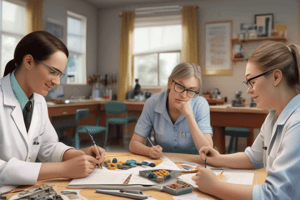Podcast
Questions and Answers
What is Activity Analysis?
What is Activity Analysis?
A way to plan and modify therapeutic activities according to a client's goals, preferences, personality, and other client factors.
What are Activity Demands?
What are Activity Demands?
The specific features of an activity that influence the type and amount of effort required to perform the activity.
What are Performance Skills?
What are Performance Skills?
Observable, concrete, goal-directed actions clients use to engage in daily life occupations.
Why is considering context and external environment important?
Why is considering context and external environment important?
What does modifying activities (grading) entail?
What does modifying activities (grading) entail?
What is scaffolding in occupational therapy?
What is scaffolding in occupational therapy?
What does fading involve in therapy?
What does fading involve in therapy?
How does coaching in therapy work?
How does coaching in therapy work?
What is the purpose of adaptation/modification in therapy?
What is the purpose of adaptation/modification in therapy?
What are assistive technology devices?
What are assistive technology devices?
What is the Americans with Disabilities Act of 1990?
What is the Americans with Disabilities Act of 1990?
What is a feature of an accessible route?
What is a feature of an accessible route?
What is a ramp's maximum slope according to accessibility guidelines?
What is a ramp's maximum slope according to accessibility guidelines?
What should be noted about steps in accessibility?
What should be noted about steps in accessibility?
What is the importance of handrails in accessibility?
What is the importance of handrails in accessibility?
What should be considered during a home assessment?
What should be considered during a home assessment?
What type of assessments can be done for home evaluations?
What type of assessments can be done for home evaluations?
What does the term universal design refer to?
What does the term universal design refer to?
What is a correlation coefficient?
What is a correlation coefficient?
What is the first type of home assessment focused on?
What is the first type of home assessment focused on?
Flashcards are hidden until you start studying
Study Notes
Activity Analysis
- Planning and modifying therapeutic activities based on client’s goals and preferences.
- Thorough understanding of tasks through breakdown of skills and components involved.
- Aims to create a challenge that is neither too easy nor too hard.
Activity Demands
- Characteristics influencing effort required for activities.
- Includes objects used, physical space needs, social aspects, sequence, timing, and necessary skills.
Performance Skills
- Observable actions utilized in daily tasks; important for engagement.
- Categories include motor skills, sensory-perceptual skills, emotional regulation, cognitive skills, communication, and social skills.
Context and Environment
- Importance of considering the individual’s environment, such as wheelchair access and family support.
- Mental health access to resources like online support groups is crucial for engagement.
Theoretical Lens
- Matching activities with appropriate therapeutic approaches, like using a biomechanical approach for clients with limited range of motion.
Modifying Activities (Grading)
- Gradually adjusting the demands of activities to enhance occupational performance.
- Can either increase or decrease difficulty, depending on client needs.
Scaffolding
- Occupational Therapist (OT) assists with challenging parts of tasks while encouraging client autonomy.
- Technique that supports motivation and confidence in clients through successful task completion.
Fading
- As client skills improve, support from OT is gradually reduced.
- Encourages independence and self-sufficiency in task performance.
Coaching
- Involves providing clear expectations and support to enhance task performance and skill development.
Adaptation/Modification
- Focuses on altering activity demands rather than changing the client’s capabilities to enhance participation in preferred activities.
Decreasing Demands
- Simplifying tasks by reducing cognitive or physical skill requirements to accommodate client needs.
Implementing Assistive Equipment (AE)
- Providing instructions for utilizing adaptive devices, such as sock aids for individuals with mobility precautions.
Altering Social/Physical Environment
- Empowering clients to communicate needs to caregivers and organizing their surroundings for better occupational performance.
Assistive Technology Devices
- Includes devices that help maintain or enhance functional capabilities for individuals with disabilities.
Assistive Technology Services
- Services facilitating selection, acquisition, or use of assistive technology devices for individuals.
Assistive Technology Practitioner
- A professional specializing in the application of assistive technologies.
Levels of Technology
- No Technology: Simple devices like grab bars and loops.
- Low Technology: Inexpensive, readily available items.
- High Technology: Complex devices requiring specialized training.
Electronic Aids to Daily Living (EADLs)
- Devices enabling control of electronic appliances through switches, enhancing independence.
Human Activity Assistive Technology Model
- Emphasizes interaction between activity, context, human skills, and assistive technologies for optimal outcomes.
Information-Processing Model
- Describes interaction of sensors, processing systems, and motor control in assistive technology usage.
Evaluation Process
- Identifying client goals, abilities, environment, and available assistive devices to inform intervention strategies.
Intervention Strategies
- Involves data collection, device trials, and ensuring proper positioning and usability.
Technologies for Sensory Aids
- Visual impairment aids include magnifiers and electronic devices.
- Auditory aids include hearing devices and accessible telecommunication.
Compensatory Technologies for Cognition
- Tools for memory aids and prompting to assist in cognitive tasks.
Mobility Technologies
- Varieties of wheelchairs with different functionalities catering to users’ needs.
Environmental Control Technologies
- Devices that improve client independence in managing household appliances.
Augmentative and Alternative Communication (AAC) Systems
- Structured communication methods for individuals with significant speech and language impairments.
AAC System Evaluation and Intervention
- Continuous assessment to align AAC systems with client needs and ensure effective communication.
Human-Technology Interface Matching
- Adapting interfaces like joysticks and switches to client capabilities for effective use.
Alternative Pointing Devices
- Options for clients with limited hand function, such as eye-gaze systems and mouth sticks.
Implementation of Devices
- Focus on positioning, vocabulary selection, and ongoing follow-up to maximize effectiveness.
Communication Competency Development
- Skills training encompasses operational, linguistic, and social competencies for effective AAC use.
Universal Design Principles
- Design aimed at inclusivity, ensuring accessibility for all individuals.
General Considerations for Universal Design
- Importance of balancing individual abilities with environmental demands to avoid maladaptive behavior.
Home Assessments
- Informing modifications to environments to support safe, independent client performance.
Types of Home Assessments
- Environmental evaluations for architectural barriers.
- Assessments of personal performance skills in the home context.
- Home environment interaction assessments when on-site evaluations are feasible.
On-Site Home Evaluation Focus Areas
- Safe mobility in and out of the home and daily activity engagement.
- Ease of functional mobility using various aids and navigating obstacles within the home.
Correlation Coefficient
- A statistical measure ranging from -1 to +1 indicating the relationship strength between two variables.
Studying That Suits You
Use AI to generate personalized quizzes and flashcards to suit your learning preferences.




